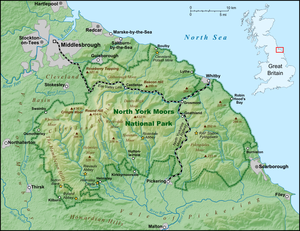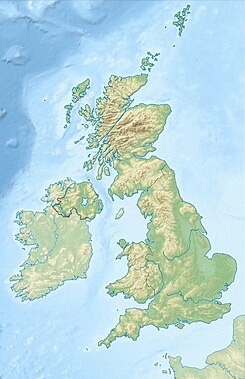|
Cleveland Hills
The Cleveland Hills are a range of hills on the north-west edge of the North York Moors in North Yorkshire, England, overlooking Cleveland and Teesside. They lie entirely within the boundaries of the North York Moors National Park. Part of the 110-mile (177 km) long Cleveland Way National Trail runs along the hills, and they are also crossed by a section of Wainwright's Coast to Coast Walk. The hills, which rise abruptly from the flat Tees Valley to the north, include distinctive landmarks such as the cone-shaped peak of Roseberry Topping, near the village of Great Ayton – childhood home of Captain James Cook.[1] GeologyThe hills are formed by multiple stacked layers of Jurassic age sedimentary rocks. The scarp rises above the low ground to the north and west formed by the mudstones of the Redcar Mudstone Formation, though largely buried beneath glacial till from the last ice age. The same formation also provides the lowermost slopes of the scarp. The full sequence, presented in stratigraphic order, i.e. youngest/uppermost at top is:[2]
Most of these formations are various combinations of sandstone, mudstone and siltstone though a couple also contain limestones and the Cleveland Ironstone and Eller Beck formations include ironstone, the former having been exploited for the ironworking industry in former times. The plateau surface is largely formed by the sandstones of the Saltwick and Cloughton formations whilst the summit of Roseberry Topping is an outlier of the Saltwick Formation separated from the main Cleveland Hills range by erosion.[3] The Cleveland Dyke cuts through the hills forming the Langbaurgh Ridge and Cliff Ridge just south of Roseberry Topping where Cliff Rigg Quarry has exploited this Palaeogene age basaltic andesite intrusion for use as roadstone. Glaciofluvial deposits are scattered around the margins of the hills, notably in Kildale whilst peat has accumulated on the plateau surface in some areas. Landslips are common in the Lias Group rocks along the scarp face in the west and in Raisdale to the south. HistoryEarly manThere are a number of tumuli and stone circles[4] scattered throughout the Cleveland Hills and North York Moors, dating back to the Bronze Age, as well as many cairns that are of varied ages, some of which are relatively modern. Hundreds of flint arrowheads have been discovered during excavations in the hills and dated to the Mesolithic and Neolithic periods, indication of an active population in prehistoric times across the region.[5] Stone circles in the Cleveland Hills
Mining and industryIn 1850 ironstone was discovered by John Marley of Bolckow and Vaughan in the Eston Hills, outliers of the Cleveland Hills, leading to mining on a large scale and the rapid growth of nearby Middlesbrough.[6][7] By the 1870s industry would be producing steel in vast amounts, and mining for coal, alum, jet, cement stone concretions, shale and potash from the hills, as well as employing sandstone and limestone quarries to gather raw materials. Many of the mines and quarries are still evident today. Hill dataThe following heights are some of the highest or most notable in the range.
Towns and villages in the Cleveland Hills There are numerous towns and villages on, or in the vicinity of, the Cleveland Hills including the following: Interesting places to see
Bilsdale West Moor, situated in the Cleveland Hills, is home to the 314 metres (1,030 ft) tall Bilsdale transmitting station, providing 40–50 miles coverage of UHF transmissions for digital TV and radio in the north-east's Tyne Tees region.[9] The digital switchover at Bilsdale was completed in two stages, on 12 and 26 September 2012, one of the last transmitters in England to complete this operation, the others being Pontop Pike and Chatton in the same region.[10] See also
References
External links |
||||||||||||||||||||||||||||||||||||||||||||||||||||||||||||||||||||||||||||||||||||


